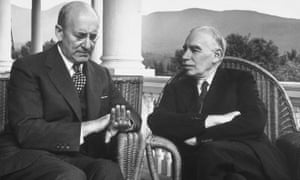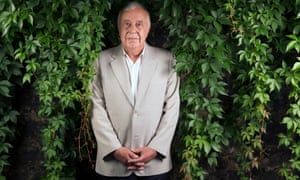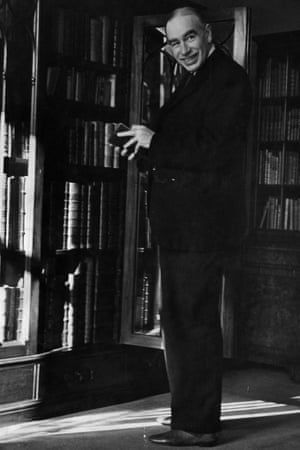Extract from The Guardian
A brief burst of Keynes prevented a
1930s-style collapse that might have led to a more fundamental
rethink of the status quo
US
Treasury secretary Henry Morgenthau Jr (left) and British economist
John Maynard Keynes conferring during the Bretton Woods international
monetary conference. Photograph: Alfred Eisenstaedt/Time & Life
Pictures/Getty Image
Larry
Elliott Economics editor
Sunday
7 February 2016 23.24 AEDT
Keynes’s General
Theory of Employment, Interest and Money is to economics
what Joyce’s Ulyssesis
to literature: a classic that lots more people start than finish. The
same applies to two other seminal works from the dismal science: Adam
Smith’s Wealth
of Nations and Karl Marx’s Capital.
It
is a fair bet, though, that a good chunk of the Keynes devotees at
last week’s British Academy celebration of the 80th anniversary of
the publication of the General Theory in February 1936 had ploughed
their way through Postulates of the Classical Economy to Notes on
Mercantilism, while only occasionally thinking they would rather be
reading Tinker
Tailor Soldier Spy.
The event pitched
Lord Robert Skidelsky, author of the magnificent three-volume
biography of Keynes, in a debate with Sir Nicholas Macpherson,
shortly to retire as permanent secretary to the Treasury. Its title,
From Keynes to Corbynomics: the General Theory at 80 was a bit of a
misnomer because Skidelsky didn’t dwell on the Labour leader’s
economic ideas and Macpherson said that, as a civil servant, it
wasn’t proper to do so. Instead, the pair took up two themes:
whether Keynes and his ideas had made a comeback following the
financial and economic crisis of 2007-09, and what Keynes would have
made of the handling of the economy by the Treasury since the crash.
Skidelsky
said there had been no lasting return to Keynesian ideas since the
market meltdown, paradoxically because a brief burst of Keynes
prevented a 1930s-style
collapse that might have led to a more fundamental re-think
of the status quo.![]()
This
seems an accurate assessment. The initial response to the crisis
followed Keynes’s ideas pretty much to the letter, with an
assumption that action should be taken to prevent what was clearly
going to be a painful recession turning into a full-blown depression.
Central
banks were the first to act. They sought to make money cheaper and
more plentiful through deep
cuts in interest rates and quantitative
easing. Keynes was primarily a monetary economist who
believed that governments should only turn to fiscal policy - raising
public spending and cutting taxes - when all other options had been
exhausted. Fiscal policy was deployed in 2008-09, but only as a
supplement to monetary policy.
Up to
a point, the strategy worked. There was no second Great Depression
and within six to nine months output had steadied across most of the
global economy. Attempts were then made to return to business as
usual as quickly as possible. That meant reducing the budget deficits
that had ballooned during the recession and making only cosmetic
changes to the debt-driven economic model that had been found wanting
from 2007-09.
Fiscal
policy was relaxed by Alistair Darling during the depths of
the crisis, but the Treasury was already returning to a more orthodox
approach to the management of the public finances even before Labour
left office in 2010. George Osborne then adopted the sort of approach
that would have been followed in the early 1930s: using low interest
rates and QE to boost growth while at the same time cutting spending
and raising taxes in order to rein in the budget deficit.
Macpherson
said the mix of loose monetary policy and tight fiscal policy had
been right, and mounted a robust defence of the Treasury’s
reluctance to run deliberately higher deficits in an attempt to boost
growth. The nine arguments presented included a lack of
“shovel-ready” projects for the government to finance, the fear
that any increase in demand would benefit foreign importers rather
than UK firms, and the likelihood that individuals and businesses
would anticipate that spending increases now would necessitate tax
increases or spending cuts later, and reduce consumer spending and
investment as a result. One questioner asked whether Macpherson was
right to say that Keynes would have approved of the government’s
economic strategy since 2008. “Of course not”, Skidelsky snorted.
So
what would Keynes say if he were still alive today and updating the
General Theory? Firstly, that one of the book’s main themes - the
difference between risk and uncertainty - has been borne out by the
financial crisis. Keynes argued that risk could be quantified but
uncertainty could not, which made all the algorithms that sought to
measure the riskiness of complex financial instruments useless in a
market gripped by panic.
John
Maynard Keynes in his library. Photograph: Tim Gidal/Getty Images
The
second lesson he would draw would be of the need to rethink the way
economics is taught, with a much reduced emphasis on mathematical
models and the restoration to the curriculum of economic history.
His
third conclusion would be that the global financial system has been
made more vulnerable by the stripping away of controls that hindered
the free movement of capital. Supporters of capital liberalisation
argue that it makes financial markets more efficient, but Keynes said
efficient markets were not necessarily effective markets and drew a
distinction between capital used for productive purposes and capital
used for speculation. The story of the years leading up to the crisis
(and the years since, for that matter) is that there was too much of
the latter and not enough of the former.
The
fourth lesson would be contained in a special chapter in the 2016
edition of the General Theory devoted to the eurozone. Keynes would
have been at his most acerbic in detailing the manifold failings of
monetary union, from its flawed
design to the succession of avoidable blunders made by the
European Central Bank and European finance ministers since 2007.
Seeking
an explanation for why the eurozone has performed so poorly in the
past eight years, Keynes would say the answer is simple: the ECB was
not only slow to cut interest rates but
raised them twice in 2011; it took more than half a decade longer
than the US Federal Reserve or the Bank of England to get round to
QE; and, most damagingly of all, European policymakers insisted on
austerity programmes that resulted in still weaker growth and even
higher levels of unemployment. Fiscal policy becomes even more
important in a monetary union, because individual countries give up
the right to set their own interest rates and to devalue (or revalue)
their currencies.
In
the fifth and final lesson, Keynes would seek to explain why the
recovery from the crash had, so far at least, been tentative and
incomplete. His argument would have been that cutting interest rates
to zero and boosting the money supply through QE were enough to
halt the downward spiral in 2009 but not sufficient to bring about a
lasting recovery.
Keynes
would say the way to achieve this would be through a global growth
pact, including more aggressive use of fiscal policy. His detractors
would say what’s needed is a dose of Joseph Schumpeter’s “creative
destruction” so that new, dynamic enterprises can replace
old, inefficient ones. In truth, policy is neither Keynesian nor
Schumpeterian, which is why we are where we are.



No comments:
Post a Comment